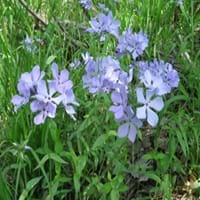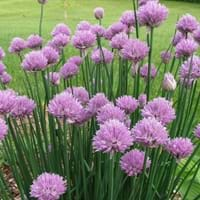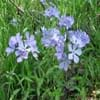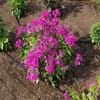Life Span
Perennial
Perennial
Type
Flowering Plants
Herbs
Origin
Northeastern United States, Mid-Atlantic United States, Southeastern United States, Central United States, Texas, Canada
World/Pandemic, North America, Europe, Asia
Types
Blue Moon, Clouds of Perfume
Common chives, Garlic chives, Siberian garlic chives, Giant Siberian chives
Habitat
Rich Woods
Rocky areas
USDA Hardiness Zone
4-8
4-9
Sunset Zone
1a, 1b, 2a, 2b, 3a, 3b, 4, 5, 6, 7, 8, 9, 10, 11, 12, 13, 14, 15, 16, 17
A1, A2, A3, H1, H2, 1a, 1b, 2a, 2b, 3a, 3b, 4, 5, 6, 7, 8, 9, 10, 11, 12, 13, 14, 15, 16, 17, 18, 19, 20, 21, 22, 23, 24
Habit
Mat-forming
Clump-Forming
Flower Color
Blue Violet
White, Pink, Lavender
Flower Color Modifier
Bicolor
Not Available
Fruit Color
Not Available
Black
Leaf Color in Spring
Green
Green, Light Green
Leaf Color in Summer
Green
Green
Leaf Color in Fall
Green
Green, Yellow green
Leaf Color in Winter
Not Available
Not Available
Leaf Shape
Ovate-lanceolate
Grass like
Plant Season
Spring
Spring, Summer, Fall
Sunlight
Partial Sun, Partial shade
Full Sun, Partial Sun
Type of Soil
Loam
Loam, Sand
The pH of Soil
Neutral
Neutral
Soil Drainage
Well drained
Well drained
Bloom Time
Spring
Late Spring, Early Summer
Tolerances
Not Available
Not Available
Where to Plant?
Container
Ground, Pot
How to Plant?
Cuttings, Seedlings
Seedlings, Transplanting
Plant Maintenance
Medium
Medium
Watering Requirements
Requires regular watering
Requires regular watering, Water every two or three days during warmer months, Water when soil is dry
In Summer
Lots of watering
Lots of watering
In Spring
Moderate
Moderate
In Winter
Average Water
Average Water
Soil Type
Loam
Loam, Sand
Soil Drainage Capacity
Well drained
Well drained
Sun Exposure
Partial Sun, Partial shade
Full Sun, Partial Sun
Pruning
Remove dead flowers
Prune in spring, Prune in summer, Prune to stimulate growth, Remove deadheads
Fertilizers
Apply 10-10-10 amount
All-Purpose Liquid Fertilizer
Pests and Diseases
Leaf spot, Powdery mildew, Rust
Bacterial leaf spot, Damping-off, Downy mildew, head rot, Pink Root, Rust, Thripes
Plant Tolerance
Drought
Drought
Flower Petal Number
Single
Single
Fragrant Bark/Stem
No
Yes
Foliage Texture
Medium
Fine
Foliage Sheen
Matte
Matte
Attracts
Hummingbirds, Butterflies
Not Available
Allergy
Mild Allergen
Asthma, Diarrhea, Itchiness, Pain and fatigue, Skin rash
Aesthetic Uses
Ground Cover
Not Used For Aesthetic Purpose
Beauty Benefits
Not Available
Not Available
Environmental Uses
Air purification
Air purification
Medicinal Uses
Boils, Eczema, Intestinal disorders
Antioxidants, Bone strength, Improve heart health, Nutrients
Part of Plant Used
Flowers, Leaves, Root
Leaves, Seeds
Other Uses
As a tea substitute, Used as eyewash
Employed in herbal medicine, Used As Food
Used As Indoor Plant
No
Yes
Used As Outdoor Plant
Yes
Yes
Garden Design
Mixed Border, Rock Garden / Wall, Wildflower
Alpine, Cutflower, Edible, Herb / Vegetable, Mixed Border, Rock Garden / Wall
Botanical Name
PHLOX divaricata 'Blue Moon'
ALLIUM schoenoprasum
Common Name
Wild Blue Phlox, Woodland Phlox
Chives, Cultivated Chives, Garden Chives
In Hindi
Wild Blue Phlox
Chives
In German
Wild Blue Phlox
Schnittlauch
In French
Wild Blue Phlox
Ciboulette
In Spanish
Wild Blue Phlox
Cebollino
In Greek
Άγρια μπλε Phlox
βολβοί φαγώσιμοι
In Portuguese
Wild Blue Phlox
Cebolinha
In Polish
Dziki Niebieski Phlox
Szczypiorek
In Latin
Phlox ferae blue
Sectivi porri
Phylum
Magnoliophyta
Spermatophyta
Class
Magnoliopsida
Liliopsida
Order
Solanales
Asparagales
Family
Polemoniaceae
Liliaceae
Clade
Angiosperms, Asterids, Eudicots
Angiosperms, Monocots
Tribe
Phlocideae
Not Available
Subfamily
Polemonioideae
Allioideae
Number of Species
Not Available
Season and Care of Wild Blue Phlox and Chives
Season and care of Wild Blue Phlox and Chives is important to know. While considering everything about Wild Blue Phlox and Chives Care, growing season is an essential factor. Wild Blue Phlox season is Spring and Chives season is Spring. The type of soil for Wild Blue Phlox is Loam and for Chives is Loam, Sand while the PH of soil for Wild Blue Phlox is Neutral and for Chives is Neutral.
Wild Blue Phlox and Chives Physical Information
Wild Blue Phlox and Chives physical information is very important for comparison. Wild Blue Phlox height is 30.50 cm and width 30.50 cm whereas Chives height is 203.00 cm and width 15.20 cm. The color specification of Wild Blue Phlox and Chives are as follows:
Wild Blue Phlox flower color: Blue Violet
Wild Blue Phlox leaf color: Green
Chives flower color: White, Pink and Lavender
- Chives leaf color: Green and Light Green
Care of Wild Blue Phlox and Chives
Care of Wild Blue Phlox and Chives include pruning, fertilizers, watering etc. Wild Blue Phlox pruning is done Remove dead flowers and Chives pruning is done Prune in spring, Prune in summer, Prune to stimulate growth and Remove deadheads. In summer Wild Blue Phlox needs Lots of watering and in winter, it needs Average Water. Whereas, in summer Chives needs Lots of watering and in winter, it needs Average Water.





